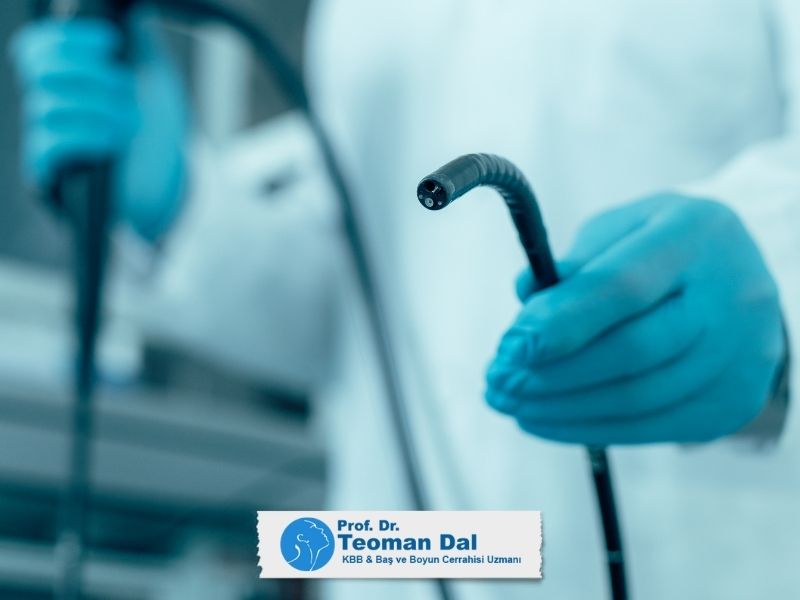Tükürük Bezi Taşlarının Tedavi Yaklaşımı
Tükürük bezi taşı tanısı konulan hastalarda, özellikle şikâyetlerle birlikte aktif enfeksiyon varsa, ilk adım bu enfeksiyonun kontrol altına alınmasıdır. Şikâyetler arasında:
- Tükürük bezinde ağrılı şişlik,
- Ağız içinde iltihaplı akıntı,
- Ciltte kızarıklık ve hassasiyet,
- Ateş gibi bulgular yer alabilir.
Bu durumda antibiyotik, ağrı kesici, ödem azaltıcı ilaçlar, bol sıvı alımı ve masaj uygulamaları ile enfeksiyon tedavisine başlanır.
Taşların Değerlendirilmesi
Akut enfeksiyon tablosu kontrol altına alındıktan sonra, ultrasonografi ile taşların boyutu, sayısı, yerleşim yeri, tükürük bezi ve kanalın durumu detaylı şekilde değerlendirilmelidir.

Küçük Taşlarda İlaçsız Takip ve Masaj
Birkaç milimetre çapında olan, düzgün yüzeyli ve tükürük bezi kanalı içinde yerleşmiş taşlar herhangi bir cerrahi müdahaleye gerek kalmadan, bol sıvı tüketimi ve taşın bulunduğu beze doğru masaj uygulamaları ile kendiliğinden atılabilir.
Endoskopik Müdahale: Sialendoskopi
Eğer taşlar sialendoskopi yöntemiyle çıkarılmaya uygunsa, işlem öncesi bilgisayarlı tomografi (BT) ile taşların yerleşimi, boyutu ve sayısı daha detaylı değerlendirilir.
Eskiden sık kullanılan sialografi işlemi (kontrast madde ile röntgen), bugün sialendoskopi ve BT’nin yaygınlaşması nedeniyle nadiren tercih edilmektedir. Sialografi; alerji riski, uygulama zorluğu ve aktif enfeksiyon durumlarında kullanılamama gibi sınırlamalara sahiptir.
Tükürük bezi taşları ilaçla tedavi edilemez. Tedavi mutlaka girişimsel yöntemleri içerir.
Büyük Taşlarda Girişimsel Seçenekler
3–4 mm'den küçük taşlar için sialendoskopi güncel ve etkili bir tedavi yöntemidir. Daha büyük taşlar için ses dalgaları, basınçlı hava veya lazer yardımıyla kırma işlemi uygulanabilir. Gerekli durumlarda sialendoskopi ile kombine edilir.
Büyük Taşlar İçin Alternatif Cerrahi Müdahaleler
- Submandibüler taşlar: Tükürük bezi kanalı içindeki taşlara ağız içinden yapılan kesilerle ulaşılabilir.
- Parotis bezindeki taşlar: Cilt altından beze ulaşılır, tükürük bezine dışarıdan kesi yapıldıktan sonra taş endoskop ışığı yardımıyla ulaşılarak çıkarılır.
- Bu yöntemlerle başarı sağlanamayan durumlarda, klasik yaklaşım olan tükürük bezinin cerrahi olarak çıkarılması uygulanabilir.
Günümüzde gelişmiş cihazlarla yapılan sialendoskopik kırma ve çıkarma işlemleri sayesinde, tükürük bezinin tamamen alınmasına çok daha az ihtiyaç duyulmaktadır.
Taşların Tekrarlamasını Önlemek İçin Öneriler
Tedavi sonrası taş oluşumunun tekrarlamaması için aşağıdaki yöntemler önerilir:
- Tükürük salgısını artıran ilaçlar
- Günlük su tüketiminin artırılması
- Tükürük akışını teşvik eden masaj uygulamaları
- Enfeksiyonu önlemeye yönelik antibiyotik tedavileri
- Kanal daralmasını önlemek amacıyla kortizon içeren ilaçlar
Tükürük bezi taşı tedavisinde erken tanı, enfeksiyonun kontrolü ve doğru cerrahi yaklaşım önemlidir. Uzun süreli rahatlık ve tekrar riskinin azaltılması için, bireysel hasta yapısına uygun tedavi planı oluşturulmalıdır.
Detaylı bilgi ve muayene randevusu için kliniğimizle iletişime geçebilirsiniz.





